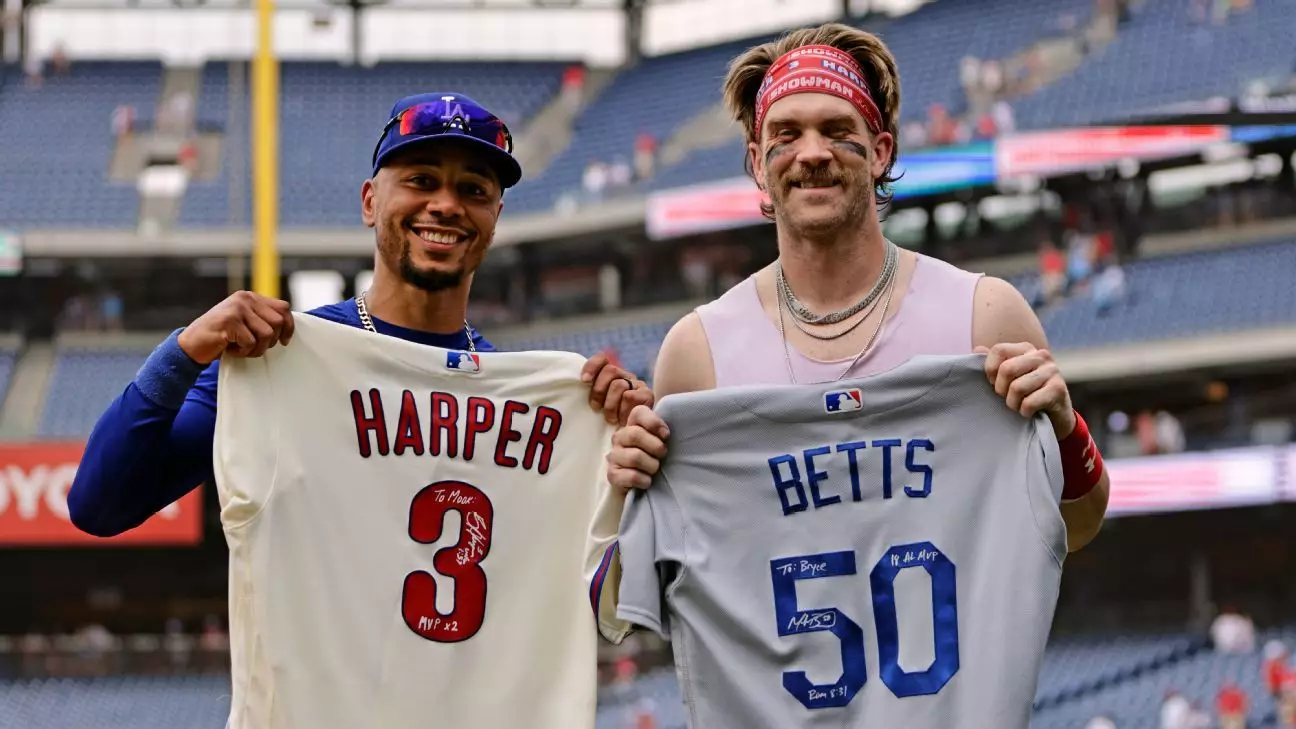In the evolving landscape of Major League Baseball (MLB), financial disparities between teams have become increasingly apparent. The recent comments from Philadelphia Phillies star Bryce Harper have brought attention to the contrasting approaches in team management. Harper, a two-time National League MVP, expressed admiration for the Los Angeles Dodgers’ financial muscle, emphasizing that criticism of such monetary strategies is unwarranted and often comes from those who may feel threatened or inadequate. Harper’s perspective illustrates a broader discourse on the issue: should fans and players celebrate the financial prowess of teams like the Dodgers or bemoan the competitive imbalance it fosters?
As of Opening Day, MLB’s average salary has surpassed the $5 million mark for the first time, according to a study conducted by The Associated Press. The staggering numbers only highlight how those high payrolls reflect not just financial investment but a winning philosophy that seeks to attract top-tier talent, regardless of location or historical competitiveness. The New York Mets led with a payroll just exceeding $322 million, closely followed by the Dodgers at nearly $320 million. Such figures are shocking yet enlightening, prompting important questions about the sustainability of this financial model and its implications for smaller market teams that struggle to keep pace.
The Significance of Deferred Payments and Team Strategy
The structure of player contracts, particularly those involving deferred payments, lends further complexity to the debate. Players like Shohei Ohtani are listed with salaries that can create misleading impressions of their actual financial impact on payrolls. Ohtani’s $70 million deal is counted as only a fraction of that value due to deferred payments spread over many years, a strategy that various franchises, including the Dodgers, have employed. While such tactics can alleviate immediate payroll pressures, they may also mask the realities of fiscal responsibility and strategic planning inherent in team administration.
Bryce Harper’s 13-year, $330 million contract forces us to reevaluate value in MLB contracts. With star players signing lucrative deals, the spotlight intensifies on teams that underperform despite high expenditures. Philadelphia has also made significant financial commitments under owner John Middleton, achieving playoff qualifications for three consecutive seasons, reinforcing the idea that spending isn’t everything—insightful team building and player development also play critical roles in sustained success.
The Growing Concern Over Competitive Balance
The question arises: does the MLB need to revise its financial framework to ensure a level playing field? Baseball Commissioner Rob Manfred acknowledged growing concern among fans regarding the absence of a salary cap in a league where financial disparity is stark. The Dodgers’ meteoric rise to the top of the payroll hierarchy raises valid questions about the inequity in accessing elite talent, particularly in small-market cities that find it challenging to invest significantly due to limited revenue streams.
While MLB functions under a system that rewards spending, competitive parity has become increasingly elusive. Harper’s candid remarks regarding the allure of playing for a franchise like the Dodgers suggest that considerable financial resources can attract elite talent and create a captivating environment for players. Los Angeles stands out as a location teeming with cultural vibrancy, exceptional cuisine, and the promise of a thrilling career—a combination that goes beyond just on-field success.
The Broader Implications for Player Movement and Team Building
High team payrolls not only influence competitive integrity but also play into the strategies players employ in seeking their next contracts. Harper’s comments resonate with the mindset of potential signings who may prioritize both financial rewards and lifestyle preferences. Players gravitate toward organizations that promise significant salaries and opportunities to shine on a grand scale, which inevitably leads to a concentration of talent within a few financially dominant franchises.
This shift can be both detrimental and advantageous. For enthusiasts of the sport, witnessing an expansion of competitive opportunities and a celebrated competitiveness becomes challenging when the focus shifts to a handful of financially sound franchises. As Harper suggests, complaints about teams like the Dodgers echo a defeatist attitude that diverges from the true spirit of competition. If a franchise has the resources, why not use them to construct a formidable lineup? The players who rise to the occasion within such organizations provide thrilling performances that reflect the ultimate goal: winning games.
The evolution of modern contracts and the financial strategies underpinning them are crucial for understanding the contemporary landscape of MLB. As Harper succinctly stated, L.A. is the mecca of sports, shedding light on how economic power shapes the trajectory of the sport. Ultimately, while the allure of big spending teams like the Dodgers presents a challenge for broader competitiveness in Major League Baseball, it also ignites passion and excitement through unparalleled performances that energize fans and shape the narrative of America’s pastime.


Leave a Reply